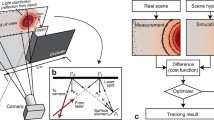Abstract
This paper presents a method for both recognising and determining the position and orientation of occluded objects. The method works by determining the extreme points of the collection of objects, and then matching these points to a database of known objects using point-pattern matching. The results of the method are insensitive to both noise and affine transformations. Computer-vision examples are given.
Similar content being viewed by others
References
N. Ayache and O. D. Faugeras, “HYPER: a new approach for the recognition and positioning of two-dimensional objects”,IEEE Trans. Pattern Anal. Machine Intelligence,8, pp. 44–52, 1986.
B. Bhanu and J. C. Ming, “Recognition of occluded objects: a cluster structure algorithm”,Pattern Recognition,20, pp. 199–211, 1987.
R. C. Bolles and R. A. Cain, “Recognizing and locating partially visible objects: the localfeature-focus method”,International Journal of Robotics Research,1, pp. 54–82, 1982.
K. E. Price, “Matching closed contours”,Proceedings of the Seventh International Conference on Pattern Recognition, pp. 990–992, 1984.
J. L. Turney, T. N. Mudge and R. A. Volz, “Recognizing partially occlused parts”,IEEE Trans. Pattern Anal. Machine Intelligence,7, pp. 410–421, 1985.
R. Ohlander, R. K. Price and D. Reddy, “Picture segmentation using a recursive region splitting method”,Computer Vision, Graphics and Image Processing,8, pp. 313–333, 1978.
M. H. Han, D. Jang and J. W. Foster, “Identification of corner-points of 2-D-images using a derivative-free line search method”,Pattern Recognition,22, pp. 13–20, 1989.
P. M. Griffin, “A point pattern matching methodology for complex objects”, Ph.D. dissertation. Texas A&M University, 1988.
N. H. Kim and A. C. Bovik, “A contour-based stereo matching algorithm using disparity continuity”,Pattern Recognition,21, pp. 505–513, 1988.
N. Kehtarnavaz and R. J. P. deFigueirdo, “A 3-D coutour segmentation scheme based on curvature and torsion”,IEEE Trans. Pattern Anal. Machine Intelligence,10, pp. 707–713, 1988.
Author information
Authors and Affiliations
Rights and permissions
About this article
Cite this article
Griffin, P.M., Villalobos, J.R. & Foster, J.W. Recognition and matching of occluded objects. Int J Adv Manuf Technol 4, 263–268 (1989). https://doi.org/10.1007/BF02601525
Accepted:
Issue Date:
DOI: https://doi.org/10.1007/BF02601525




